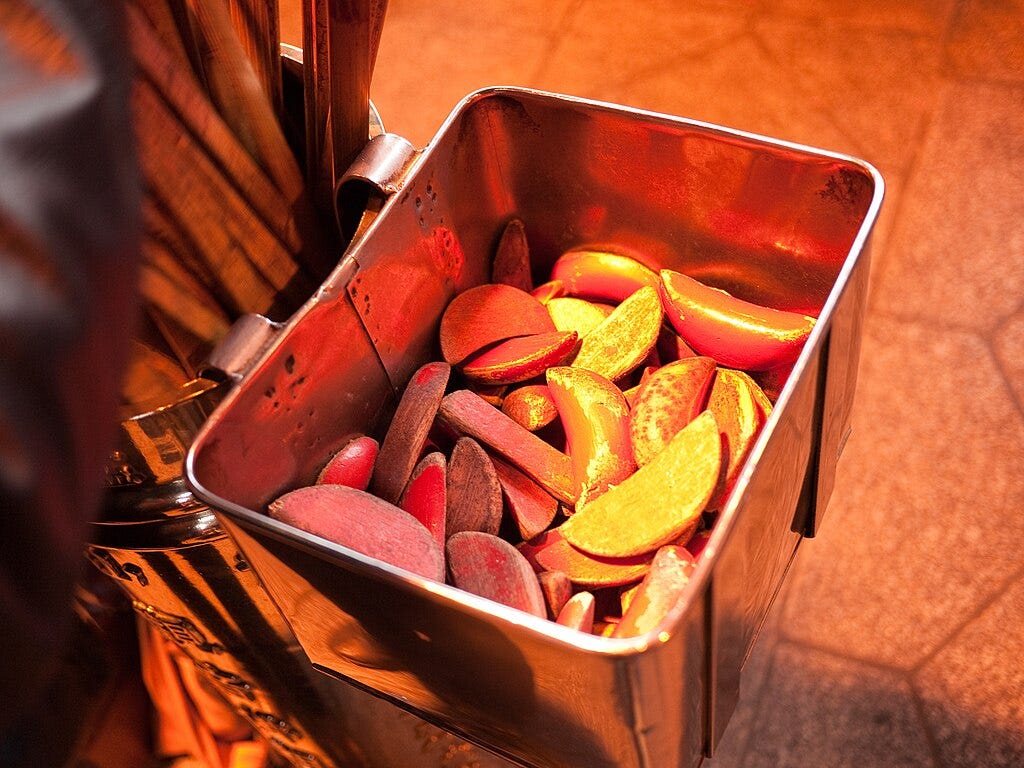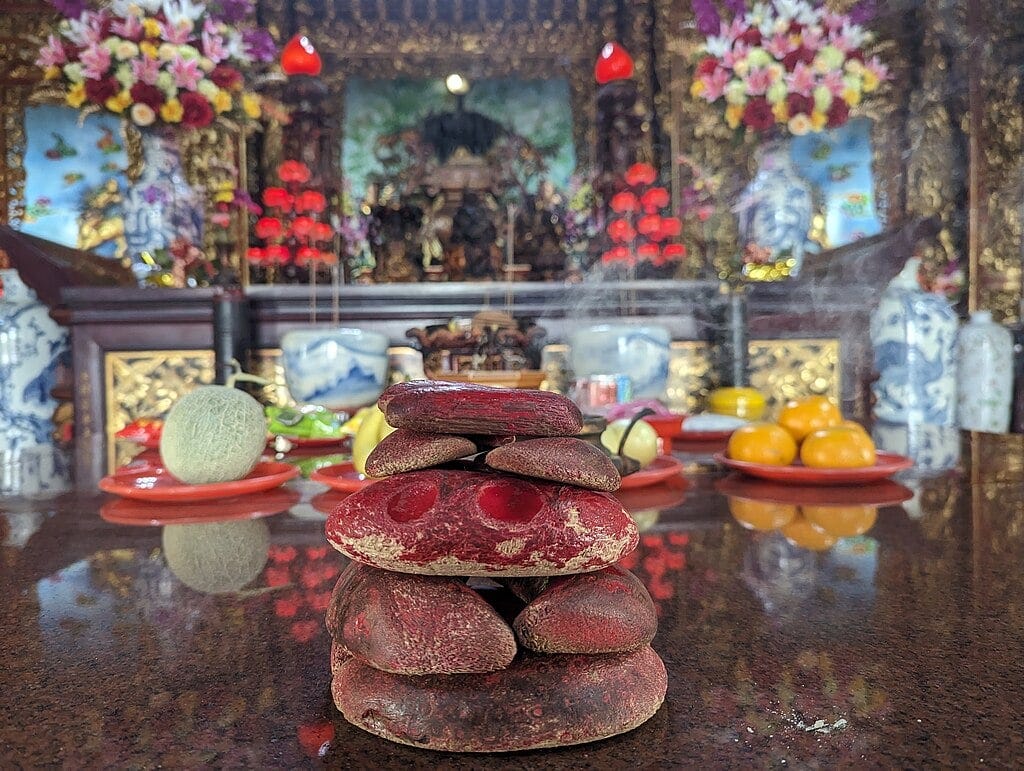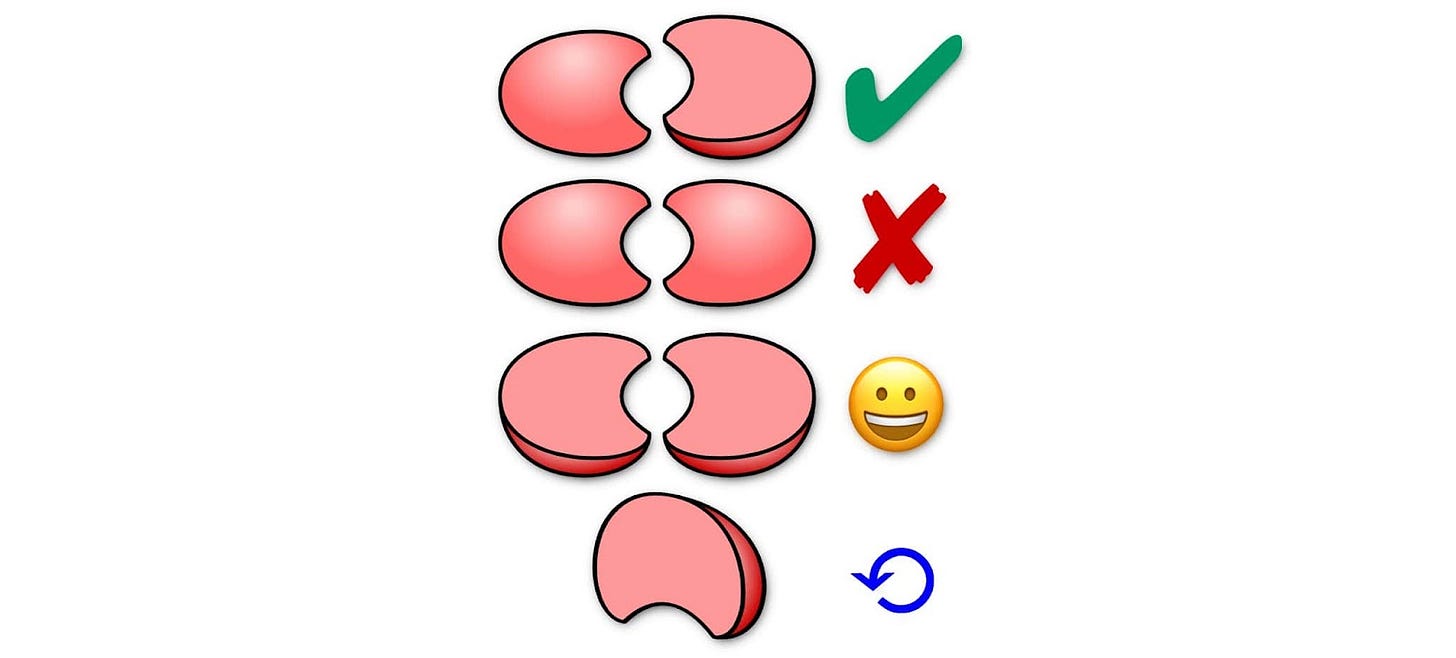Moon block divination (筊杯) is core not only to the folk-religious side of Taoism, but to Taiwanese culture as a whole. Just as Western soap operas wouldn’t be what they are without evil twins and secret pregnancies, the Taiwanese equivalent of the “8 o’clocker” (八點檔) would lose all its flavor without climactic pans of the camera from shocked expressions down to red crescent blocks on the ground.
But what exactly are these blocks; how do we interpret them; and how can you, too, partake in moon block divination?
Many across history have looked up at the night sky, stared into the starry void, and wondered: What did Taiwanese rapper Leo Wang mean when he rapped to a chill, reggae tune the words: “If you don’t get what I'm thinking, why don't you go pua̍h‑pue?”
No, that’s wrong. I meant that they’ve wondered what the future holds; whether they have the heavens’ blessings; and what, in this situation, the gods, buddhas, or bodhisattvas would have them do?
But to answer that question, let’s return to the first. What did Taiwanese rapper Leo Wang mean when he suggested that the people who didn’t get him go to a temple and do a bit of moon block divination (have themselves a pua̍h‑pue)?
Of course, he was being irreverent. He was saying: If you're going to misunderstand me or put words in my mouth, then you might as well ask the gods what I'm thinking. But if we took him seriously, what exactly would that entail?
What is moon block divination?
Moon block divination, or “pua̍h‑pue,” is kind of like shaking a Magic 8 ball, except there’s no ball, no blue fluid, and no 20-sided dice with answers engraved on the sides (yes, that’s what’s inside a Magic 8 ball).
Instead, you have two crescent-shaped “moon blocks,” often painted red, that are rounded on the top (the “yin” side) and flat on the bottom (the “yang” side). You throw them on the ground, and get one of three results: the blocks are either all face-up; all face-down; or one is face-up and the other is face-down.
(✔️) A “divine poe” (聖杯) or “yes poe,” is indicated by 1 upright block and 1 upside-down block.
(✖️) A “yin poe” (陰杯) or “no poe,” is indicated by 2 upright blocks (round sides up, flat sides down).
(😀) A “laughing poe” (笑盃), is indicated by 2 upside-down blocks (flat sides up, round sides down) – which signifies unsureness, like a shrug of the shoulders.
Etymology
“Moon block” isn’t a literal translation of “pua̍h‑pue,” but a word invented to accommodate the foreigner’s intuition (“Oh, that must mean those crescent moon-shaped blocks”).
The compound Taiwanese term “pua̍h‑pue” (跋杯), however, has literal and historical significance. “Pua̍h,” pronounced something like “bwaw,” technically means “to gamble,” according to the Moedict Taiwanese dictionary – but really, the implication is that something like a dice is being “thrown.” “Pue” or “poe,” pronounced “bway,” means “cup,” and refers to the cup-like crescent “moon blocks” themselves.
We get a similar analysis if we go by the Mandarin term “zhíjiǎo” (擲 = to throw [dice, etc.], 筊 = moon block), too – though, in Taiwan, people usually just say “pua̍h‑pue” even when speaking Chinese.
Step-by-step guide
So now we know what moon blocks are and what it looks like when we throw them. But how do you actually get started doing moon block divination yourself?
1. Making the rounds at a temple
The first step is finding a temple with moon blocks and making the rounds. This means going to every deity in the temple one-by-one to introduce yourself, and usually also planting incense sticks in their burners.
This can undoubtedly be the most confusing part of poe divination (and just visiting a temple in general), and the more deities a temple houses, the more complicated it can be.
Best case scenario, you’ll find instructions posted somewhere in the temple which tell you:
A) How many incense sticks to pick up total (you can just take them from the bin for free and light them with a nearby burner)
B) How many incense sticks to put in each deity’s incense burner
C) And what order to visit the deities in
If you can’t though, it’s fine. Either just copy what other people are doing, or maybe just plant 1 incense in every minor deities’ burner and 3 in the main deity’s. Alternatively, you can keep a lookout for English guides for specific temples written by me or others,
Either way, once you’ve picked up and lit your incense sticks (“joss sticks”), go from deity to deity in whatever order you think is probably correct; bow with your incense sticks held in front of you in both hands (careful not to poke yourself in the eye or set your hair on fire); and introduce yourself to whoever you’re standing in front of (name, address, date and time of birth, and reason for visiting) before sticking the sticks upright in the burner ash. The gods should be able to understand you no matter what language you introduce yourself in, so don’t get too hung up on that.
2. Choose a deity to consult
Now for the divining proper.
After you’ve made your rounds greeting the temple deities, it’s time to go back to the specific god you want to consult. Often, this will be a deity related to the domain of your problem (the Man Under the Moon for love and marriage, etc.). When in doubt, though, you can always just go to the temple’s primary deity (usually the biggest idol with the grandest throne). If you aren’t sure even about that, though, just find the deity with the bucket of moon blocks next to it.

3. Purify the blocks
Once you’ve found a deity and have a pair of moon blocks in hand, look for the nearest incense burner (the cauldron filled with ash with incense sticks sticking out of it). Hold the blocks over the sticks and make three circles. It doesn’t matter if you go clockwise or counterclockwise – this is just about getting them good and covered in that holy smoke to purify them of whatever residual “energy” the previous user left on them.
4. Check if the deity is around
Now we can start throwing those moon blocks around.
This is actually a step I’ve noticed many friends skip; that said, if you want to do things by the book, start by asking the deity if they’re around and can answer some questions for you in a polite, reverent manner. (“Hi, is the god in today?”).
If you get a “yes poe,” you can proceed. Otherwise, take a walk and check in again a few minutes later.
Note that it’s traditionally recommended that you wait for 3 “divine poes” in a row before this or any other question is considered a definite “yes.” Some high-traffic temples (like Hsingtian Temple in Taipei), however, specify that with their deities, “yes” means “yes” – and in fact, the Hsingtian Temple website even says that repeated questioning is seen as a sign of obstinance.
5. Introduce yourself and explain your question
Remember how you introduced yourself to all the gods earlier? Once you’ve made sure the deity is in, you need to remind them who you are again.
Now, ask your question in brief, clear terms – if you aren’t getting to the point and the god doesn’t know what you’re trying to say, be prepared for a “laughing poe” (essentially an awkward shrug).
Keep it simple – again, like you’re asking a Magic 8 ball. Even if the issue is complex, make sure there’s a yes-or-no question at the end of it.
6. Wait
Finally, you got that off of your chest! Don’t you feel better?
But hold onto your blocks; the gods need time to go through their files and make sure they have their facts straight before giving you an answer. How much time? About 10 - 15 minutes should do it (the time it takes for an incense stick to burn halfway).
Though, again, this is a step I often see people skipping – and wouldn’t be surprised if this was actively discouraged by some busier temples.
If you want, you can even straight up ask the deity if they can give you an answer right away (you only need one “yes poe” for this question).
7. Throw the blocks
Now you get to throw your moon blocks and see what the deity has to say about your conundrum. Go ahead; throw them right there on the ground. I promise you won’t get into trouble – just don’t hit anyone with them.
Again, though, if you want to play it safe – and unless otherwise specified by the temple – you don’t want to consider any “yes” definite unless you get 3 “divine poes” in a row.
8. Clarify your answer
But how should you interpret the answer you receive – especially if you get something like a “yes” mixed with a few “nos” or “laughs,” if you’re going the 3-in-a-row route?
Clarify.
If you get back some nos, or even all nos, rephrase the question as its opposite and ask the deity if this is what they meant.
For example, if you asked if you should take a job somewhere and the deity gives you some negative (“yin poe”) feedback, ask: Do you mean that I should tell the company that I’m not interested when we talk on the phone tomorrow? Or, if you keep getting “laughing poes,” try rephrasing the question.
Keep asking clarifying questions based on the feedback you receive until you get a definite, unambiguous answer.
Also, don’t overlook the significance of a “laughing poe.” A shrug doesn’t just mean “hell, I don’t know mortal, do whatever you want.” In addition to meaning your question is unclear, it could also mean that you aren’t asking the right questions, or even that you’re asking the wrong deity – what are you doing asking the god of matchmaking about how to deal with your hard-headed boss, anyway?
Thanking the deity
Now you should have an answer, and maybe even some peace of mind. So how do you go about thanking the god?
Some deities are satisfied just helping mortals out. Others will accept an offering in return – a practice known as “aspiration redeeming” (還願).
So what route should you take?
Start by following the advice you’ve been given.
Then if everything works out, maybe come back with an offering that the deity likes. Of course, you can ask the temple staff or look for a sign – but if you can’t read or speak Chinese, just look for what other people have put on the offerings table and get something similar.
Usually, this will be fruit, candy, snacks, maybe even some ghost money. In some temples, you can even buy a pre-arranged “offerings package” from the front desk. In the latter case, you can generally just leave the offerings (i.e. ghost money, incense, etc.) on the table for the temple staff to burn for you. In the former, you’re expected to leave your snacks for about an hour before coming back to pick them up, after which you can take them home and eat them yourself (though you can choose not to come back and donate them to the temple staff, too).
If all of that’s too complicated, just remember: If you don’t want to make a second trip but do want to make an offering, just bring a generic snack food to the temple and put it on the table before you leave.
Eric R Stone is an American journalist and translator of Chinese Buddhist and Taoist scripture and commentary living in Taipei. He’s translated four books: Happiness & Suffering, The Tao Te Ching: Wondrous Revelations, Emptiness Energy, and The Secret of Chan. His writing has appeared in Lacuna Magazine, The News Lens, Taiwan News, and The ATA Chronicle. In his free time, he has been running a multi-year Mandarin D&D campaign. Keep up with his writing at ericrstone.substack.com, or learn more at ericrstone.com




